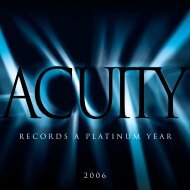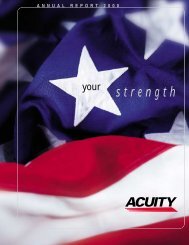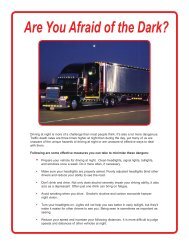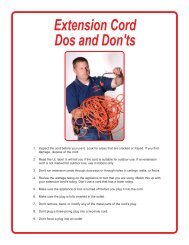Bench Grinder Safety.pdf - Acuity
Bench Grinder Safety.pdf - Acuity
Bench Grinder Safety.pdf - Acuity
Create successful ePaper yourself
Turn your PDF publications into a flip-book with our unique Google optimized e-Paper software.
<strong>Bench</strong> <strong>Grinder</strong> <strong>Safety</strong><br />
<strong>Bench</strong> grinders can be found in almost any workshop. Because grinders can produce wheel speeds of<br />
9,000 to 14,000 revolutions per minute (rpm), they can expose the operator to many serious hazards.<br />
The correct use of personal protective equipment (PPE) can prevent many injuries associated with<br />
bench grinders.<br />
Here are some safety tips when using a bench grinder:<br />
• Wear the correct eye protection—safety glasses with side shields along with full face shield for<br />
high velocity and flying particles.<br />
• Don’t wear loose-fitting clothing or jewelry when operating grinders or other moving equipment.<br />
• Be sure you are using the correct grinder and wheel for the job you are doing. The wheel<br />
should be designed for that grinder. Certain materials require specific types of wheels.<br />
• Verify that the grinding wheel rpm rating is matched or rated higher than the rpm rating of the<br />
grinder motor.<br />
• Be sure all guards are in place. Adjust the tongue guard to within 1/4 inch of the wheel surface.<br />
• Adjust the tool rest to within 1/8 inch of the wheel surface to prevent objects from being pulled in.<br />
• “Ring Test” grinder wheels before mounting them. If you hear a clear ringing tone, it is in good<br />
condition. If it sounds dull, replace it.<br />
• Inspect the wheels for hairline cracks before using. Do not use a cracked wheel.<br />
• Don’t operate a grinder unless it is securely mounted to a workbench or floor.
Here are some safety tips when using a bench grinder: (continued)<br />
• Tag the grinder and remove it from service if you find any defects.<br />
• Stand to one side as you start the grinder. A defective wheel is most likely to explode when<br />
being started.<br />
• Let the grinder reach operating speed before starting to work. This is usually about one minute.<br />
• Use the tool rest and bring the work slowly into contact with the wheel. Do not force the<br />
material into the wheel. Use minimum force. Excessive force may cause kickback.<br />
• Use clamping pliers when grinding parts that cannot be held easily by hand.<br />
• Use only the correct surface of the wheel. Do not use the side of the wheel as this can cause<br />
the wheel to disintegrate.<br />
• Maintain good housekeeping around the grinder workstation. Don’t allow sparks from grinding<br />
to fly into combustible or flammable materials such as scraps or solvents.<br />
• Turn off the grinder when you are done using it. Wait until it comes to a complete stop. Never<br />
stick an object into the wheel to stop the grinder more quickly.<br />
<strong>Bench</strong> grinders are a source of many workplace injuries. Protect yourself—especially your eyes—<br />
when you use any type of grinder.<br />
For All That Matters<br />
800.242.7666<br />
2800 South Taylor Drive . Sheboygan, WI 53081<br />
www.acuity.com<br />
The content of this document is general in nature and provided to you for informational purposes only. The information is derived from sources believed to be reliable and is<br />
offered as a resource to be used together with guidance from your professional insurance, legal, and safety advisors in maintaining a loss prevention program. ACUITY assumes<br />
no liability by reason of the information contained in this document. If you have a specific concern, you should contact your professional insurance, legal, or safety advisors.



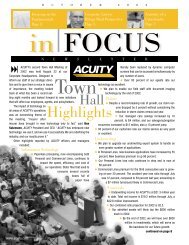
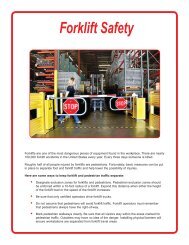


![Proper Lifting Techniques [PDF] - Acuity](https://img.yumpu.com/46891068/1/190x143/proper-lifting-techniques-pdf-acuity.jpg?quality=85)

